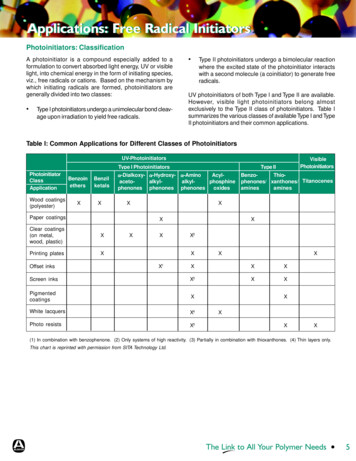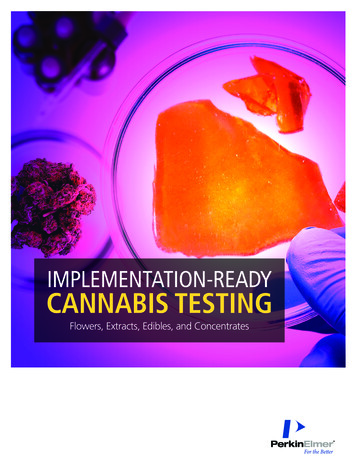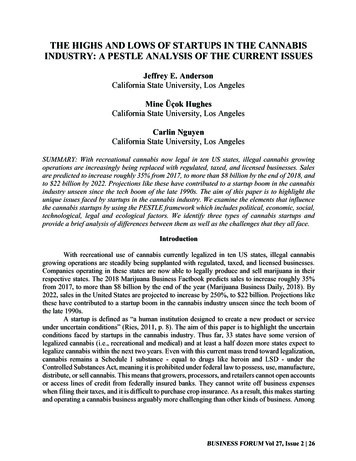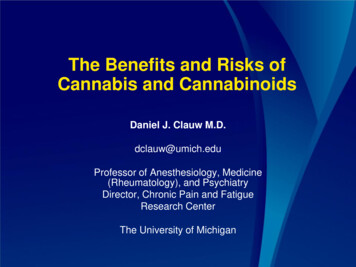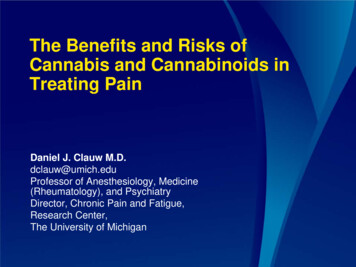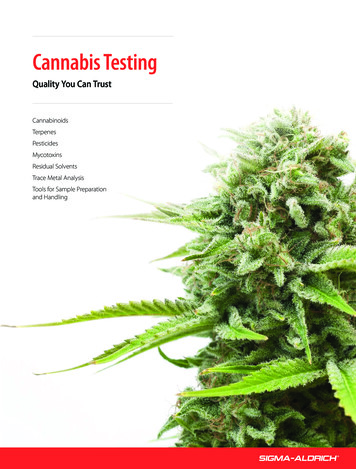
Transcription
Cannabis TestingQuality You Can ual SolventsTrace Metal AnalysisTools for Sample Preparationand Handling
Pesticides p. 10–13Terpenes p. 8–9ClH3CClMycotoxins p. 14–22OClOOCH3ClCH2OClOCannabinoids p. 4–7OResidual Solvents &Heavy Metals p. 23–26CH3OHHH 3COCH3CH3OCH3NCH3Tools p. 27 SAMPLE C and UHPLCStandards and CRMSPE Cartridgesand AccessoriesGC and GC-MSMulti-component MixesSolventsSolventsELISACannabis Testing
CANNABIS TESTINGAs of January 2015, 23 states and the District of Columbia of the United States (U.S.) as well as Canada andvarious European countries, have passed laws allowing Cannabis to be used for medical applications.Four U.S. states also allow for the recreational use of Cannabis.Currently, laws regulating manufacturing practices and qualitystandards of Cannabis source materials are few or nonexistent andvary widely among jurisdictions. In order to alleviate patient concernsregarding the efficacy and safety of Cannabis-derived therapeutics,Cannabis quality control testing is mandated in many jurisdictions.Our Cerilliant brand pioneered commercially available certifiedsolution standards and U.S. DEA-exempt solution standards ofcontrolled substances, including cannabinoids. We offer the broadestselection of Cannabis Certified Reference Materials (CRMs) andanalytical standards for cannabinoids, terpenes, mycotoxins, heavymetals, pesticides, and residual solvents.This brochure provides a selection of tools and consumables for thescientists performing analytical testing of Cannabis. Included are: QuEChERS reagents and SPE tubes for pesticide and other analytes. scentis Express U/HPLC columns for cannabinoids, terpenes,Apesticides, and other analytes.Supel Tox SPE cartridges to simplify mycotoxin analysis. More than10 faster, simpler, and more reproducible than immunoaffinitycolumns.For more information, visitsigma-aldrich.com/cannabisFor more information, visit sigma-aldrich.com/cannabis3
CANNABINOIDSSTANDARDS, CRMS, COLUMNS, AND SOLVENTS FOR CANNABINOID ANALYSISCannabinoids are a class of psychoactive and nonpsychoactive compounds produced in the Cannabis (marijuana) plant.In recent years, these compounds have shown potential therapeuticefficacy in the treatment of pain, mood disorders, and inflammatorydiseases. Since the concentration-to-potency of cannabinoids inCannabis can fluctuate through various stages of plant growth andin different plant strains, it is imperative for patients that Cannabiscultivators ensure cannabinoid identity as well as consistent purityand concentration.1Cannabinoids can be analyzed using multiple methods includingseparation by GC, LC, or UHPLC, and identification by MS. We offer acomplete line of relevant products for cannabinoid potency testingincluding GC and HPLC columns, solvents, and certified referencematerials (CRMs).Included here are examples relevant to cannabinoid testing.Standards and CRMs for Cannabinoid AnalysisCANNABINOID STANDARDS AND CRMSStructural formulas of main natural cannabinoidsBelow is a list of products show in the examples as well as others of relevance to cannabinoid testing workflows.ComponentConcentrationSolventUnit SizeCat. 3Cannabidivarin (CBDV)Cannabigerol (CBG)Cannabigerolic acid (CBGA)Cannabichromene (CBC)Cannabidiolic acid (CBDA)(-)-Δ9-THC-D3(-)-Δ9-THC100 µg/mL1.0 mg/mL1.0 mg/mL100 µg/mL1.0 mg/mL1.0 mg/mL1.0 mg/mL1.0 mg/mL1.0 mg/mL100 anolMethanolMethanolMethanolMethanol1 mL1 mL1 mL1 mL1 mL1 mL1 mL1 mL1 mL1 031.0 mg/mL1.0 mg/mL1.0 mg/mL1.0 mg/mL1.0 mg/mL1.0 nol1 mL1 mL1 mL1 mL1 mL1 Δ8-THCexo-THCΔ9-Tetrahydrocannabinolic acid A (THCA-A)Tetrahydrocannabivarin (THCV)References1. Elsohly MA. Marijuana and the Cannabinoids. New Jersey, Humana Press Inc., 2007.4Cannabis Testing
ASCENTIS EXPRESS COLUMNS FOR FAST HPLCComparison of Fused-Core and Standard HPLC Particle(2.7 μm particle shown)Ascentis Express ParticleTotally Porous Particle0.5 µm1.7 µm2.7 µmDiffusion PathAnalysis of Cannabinoidsby HPLC1.5 µmThe rapid growth of the Cannabis testing market has promptedthe development of equally rapid methods to analyze the activeingredients. Shown here are separations of various cannabinoidson Ascentis HPLC columns. Cerilliant CRMs provided reliableidentification and quantification.Key Features and Benefits Maximize speed with sharp peaks even at ultra-high flow ratesExtend column lifetime with rugged Fused-Core particlesSuitable for all HPLC, UHPLC, and LC-MS instrumentsAchieve UHPLC performance on traditional HPLC systemsAvailable in 2.0, 2.7, and 5 μm particlesBased on innovative Fused-Core particle technology, Ascentis Express 2.7 μm provides the high speed and high efficiency ofsub‑2 μm particles, but at approximately half the backpressure for thesame column length. This lower pressure means that Ascentis Expresscan be run on conventional HPLC and LC-MS systems, as well asmidpressure or ultra-high pressure (UHPLC) systems. Lower pressurealso means longer columns can be used for additional resolvingpower. Ascentis Express 2.7 μm particles offer these benefits oversub-2 μm particles, along with excellent column lifetime.At the heart of Ascentis Express is the Fused-Core particle whichcomprises a solid core and a porous shell. Compared to totally porousparticles, the Fused-Core particles have a much shorter diffusion pathbecause of the solid core. This partial porosity reduces axial dispersionof solutes and minimizes peak broadening. Other features, such as avery tight particle size distribution and high packing density, resultin Ascentis Express 2.7 μm particle columns that are capable of240,000 N/m and higher: comparable to the efficiency of sub‑2 μmparticle columns and nearly twice the efficiency possible with 3 μmparticles. The increased efficiency of Ascentis Express columnsenables you to use shorter columns and save solvents. Ascentis Express 2 μm particles provide an optimized solution forhigh-throughput small molecule analysis.Ascentis Express 5 μm particles give exceptional “pressure-perperformance” ratio compared to both 5 μm and 3 μm totallyporous particles.Shown below is the separation of Cannabis compounds on anAscentis Express RP-Amide column. The selectivity, and thereforeresolution, is unique to the amide bonded phase chemistry.Figure 1. HPLC Analysis of Cannabinoids using Ascentis ExpressRP-Amidecolumn: Ascentis Express RP-Amide, 15 cm 4.6 mm I.D., 5 μm particles(50774-U)mobile phase: 5 mM ammonium acetate (pH 4.5 with acetic acid) in 20:80,acetonitrile: waterflow rate: 1.0 mL/minpressure: 1450 psi (100 bar)column temp.: 35 Cdetector: UV, 214 nminjection: 5 -Δ8-THC2.02343.04.0Min5.06.07.08.0Figure 2. HPLC Analysis of Cannabinoids using Ascentis C18column: Ascentis Express C18 10 cm 2.1 mm, 2.0 µm particle size (50813-U)mobile phase: [A] 0.1% formic acid; [B] 0.1 % formic acid in acetonitrileflow rate: 0.4 mL/minpressure: 6300 psicolumn temp.: 35 Cdetector: UV 280 nminjection: 1 µLReferences6Min1. Elsohly MA. Marijuana and the Cannabinoids. New Jersey, Humana Press Inc., 2007.For more information, visit sigma-aldrich.com/cannabis5
SLB-5MS CAPILLARY GC COLUMNSAscentis Express HPLC Columns (2.7 µm)ComponentCat. No.C18, 5 cm 2.1 mm I.D.C18, 10 cm 2.1 mm I.D.RP-Amide, 10 cm 2.1 mm I.D.Phenyl-Hexyl 10 cm 2.1 mm I.D.Phenyl-Hexyl 15 cm 2.1 mm I.D.53822-U53823-U53913-U53336-U53338-U HPLC & LC-MS SolventsFor a comprehensive overview on our solvents for HPLC & LC-MSapplications, the LiChrosolv & LiChrosolv hypergrade for MSproduct lines, please visit us at sigma-aldrich.com/lcms-solvents Application: The 5% phenyl equivalent phase provides a boilingpoint elution order with a slight increase in selectivity, especially foraromatic compounds. The low bleed characteristics, inertness, anddurable nature make it the column of choice for anywhere a lowbleed non-polar column is requiredUSP Code: This column meets USP G27 and G36 requirementsPhase: Bonded and highly crosslinked; silphenylene polymervirtually equivalent in polarity to poly(5% diphenyl/95% dimethylsiloxane)Temp. Limits: 0.32 mm I.D.: –60 C to 340 C (isothermal) or 360 C(programmed)Temp. Limits: 0.53 mm I.D.: –60 C to 330 C (isothermal) or 340 C(programmed)GC ColumnsAnalysis of Cannabinoids by GCComponentCat. No.SLB-5ms, 10 m 0.10 mm I.D., 0.10 µmSLB-5ms, 15 m 0.10 mm I.D., 0.10 µmSLB-5ms, 20 m 0.18 mm I.D., 0.18 µmSLB-5ms, 20 m 0.18 mm I.D., 0.36 µmSLB-5ms, 30 m 0.25 mm I.D., 0.25 µmSLB-5ms, 30 m 0.25 mm I.D., 0.50 µm28465-U28466-U28564-U28576-U28471-U28473-UGC, with either flame ionization or MS, can be used for cannabinoiddetection. Derivitization, typically silylation, is required for determinationof cannabinoid acid species. We offer a full line of derivitizationreagents in addition to a full line of GC columns.Below is a selection of our most popular products.Derivitization ReagentsComponentCat. No.Silylation Sampler A Derivatization GradeBSTFA, Derivatization Grade for GC derivatizationBSTFA TMCS, 99:1HMDS TMCS, 3:1:9 (Sylon HTP)TMSI, Derivatization Grade pBoron trifluoride-methanol 7166Cannabis Testing
Analysis of Cannabinoids by Thin Layer ChromatographyTHIN LAYER CHROMATOGRAPHY REAGENTSThin Layer Chromatography (TLC) has been used for many years to identify the presence of cannabinoids due to the speed and simplicity of theapproach. We offer a full range of products for use in TLC. Below is a selection of our most popular products.LC Glass Plates from EMD/Merck KGaAL ength WidthLayer ThicknessBinder / IndicatorCat. No.10 cm 20 cm10 cm 20 cm2.5 cm 7.5 cm2.5 cm 7.5 cm20 cm 20 cm20 cm 20 cm20 cm 20 cm20 cm 20 cm5 cm 10 cm5 cm 10 cm250 μm250 μm250 μm250 μm250 μm250 μm250 μmNA250 μm250 μmbinder Polymeric / fluorescent indicatorbinder Polymeric / fluorescent indicator: Nobinder Polymeric / fluorescent indicatorbinder Polymeric / fluorescent indicatorbinder Polymeric / fluorescent indicator: Nobinder Polymeric / fluorescent indicatorbinder Polymeric / fluorescent indicatorbinder: No / fluorescent indicatorbinder Polymeric / fluorescent indicatorbinder Polymeric / fluorescent 4Z293032Z740215Z292990Z740212For more TLC plates, please also visit us at sigma-aldrich.com/tlcSolvents and Reagents for TLCDescriptionCat. No.Chloroform, anhydrous, contains amylenes as stabilizer, mineFast Blue BB Salt hemi(zinc chloride) salt3729783696721473629630924451147121644670For more information, visit sigma-aldrich.com/cannabis7
TERPENESSTANDARDS, CRMS, COLUMNS, AND REAGENTS FOR TERPENE ANALYSISTerpenes are the primary aromatic constituents of Cannabis resinand essential oils. These compounds vary in type and concentrationamong different genetic lineages of Cannabis and have been shownto modulate and modify the therapeutic and psychoactive effectsof cannabinoids.1 Therefore, the analysis of terpenes is critical toensuring Cannabis strain identity and medical efficacy.Similar to cannabinoids, terpenes can be analyzed using multiplemethods including separation by GC or LC and identification by MS.We offer a complete line of relevant products for terpene analysis forany matrix such as GC and HPLC columns, solvents, standards andcertified reference materials.Standards and CRMsComponentUnit SizeCat. No.Borneol*( olSabinene bolol( ne*Δ3-Carene*100 mg1g100 mg1 mL100 mg25 mg1 mL1 mL, 5 mL250 mg25 g, 50 g1 mL, 5 mL100 mg100 mg100 mg, 500 mg1 mL500 mg, 5 g100 mL, 500 mL25 g, 100 g1 mL, 5 mL1 mL1 mL250 mg1 mL, 5 mL100 mg1 mL, 5 mL100 mg100 mg10 mg, 50 mg100 mg100 35†PHY80088†† Distributed product – Products will be provided with the manufacturer’s COA.Distributed items are available directly through Cerilliant in the U.S. and Canada.Supelco and Cerilliant brands available through sigma-aldrich.com.*Cerilliant ProductReference1. Russo EB, “Taming THC: potential cannabis synergy and phytocannabinoidterpenoid entourage effects.” Br J Pharmacol. 2011 Aug;163(7):1344-64. doi:10.1111/j.14765381.2011.01238.x8Cannabis Testing
Analysis of Terpenes by HPLCASCENTIS EXPRESS COLUMNS FOR FAST HPLCAscentis Express HPLC Columns (2.7 µm)ComponentCat. No.C18, 5 cm 2.1 mm I.D.C18, 10 cm 2.1 mm I.D.RP-Amide, 10 cm 2.1 mm I.D.Phenyl-Hexyl 10 cm 2.1 mm I.D.Phenyl-Hexyl 15 cm 2.1 mm I.D.53822-U53823-U53913-U53336-U53338-UAnalysis of Terpenes by GCGC, with either flame ionization or MS, can be used for terpenedetection. Derivitization, typically silylation, is required for determinationof relevant species. We offer a full line of derivitization reagents inaddition to a full line of GC columns. Below is a selection of our mostpopular products. Derivitization ReagentsComponentCat. No.Silylation Sampler A Derivatization GradeBSTFA, Derivatization Grade for GC derivatizationBSTFA TMCS, 99:1HMDS TMCS, 3:1:9 (Sylon HTP)TMSI, Derivatization Grade pBoron trifluoride-methanol 71
selection of Cannabis Certified Reference Materials (CRMs) and analytical standards for cannabinoids, terpenes, mycotoxins, heavy metals, pesticides, and residual solvents. This brochure provides a selection of tools and consumables for the scientists performing analytical testing of Cannabis. Included are: QuEChERS reagents and SPE tubes for pesticide and other analytes. Ascentis .
